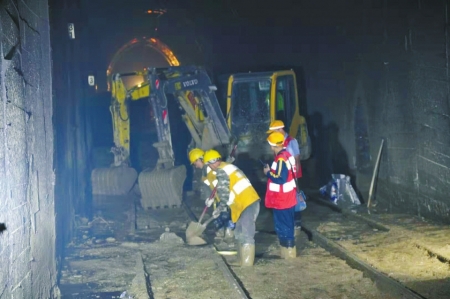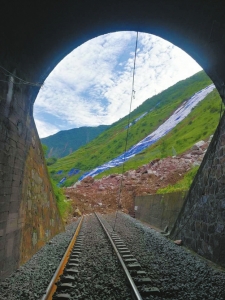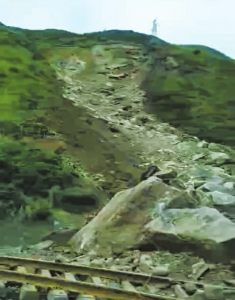Some rescuers lost contact in sudden rock collapse in chengdu-kunming railway.

After the first two railway interruptions, rescue workers rescued in the tunnel.

The railway at the tunnel entrance was buried.

Rock mass collapse site on 14th.
At about 12: 44 noon on August 14th, tens of thousands of high rock masses suddenly collapsed between Lianghong and Aidai Station in chengdu-kunming railway, Ganluo County, Liangshan Prefecture, and the line was interrupted again, which led to the loss of some rescue workers on site. The exact number is being verified.
Since the end of July, chengdu-kunming railway has been interrupted for three times due to heavy rainfall, and the Ganluo section of the line has been in the emergency recovery stage for half a month. According to the announcement of the railway department, the passenger train from Chengdu to Xichang will be suspended until August 30.
During the interruption of chengdu-kunming railway, in order to ensure passengers’ travel, the railway department tried every means to tap the transportation capacity, reconnected the EMU from Chengdu East to Kunming South, and added ordinary passenger trains from Xichang to Panzhihua and Kunming, so as to facilitate passengers’ travel along the route to the greatest extent.
Live video display
A lot of earth and stone poured down from the railway.
A tunnel entrance railway was buried.
After the disaster, the railway department immediately launched a level I response, quickly organized forces, and worked with local firefighters to fully carry out rescue. At present, the collapse of the mountain continues, which has a great impact on the rescue work. The collapse caused the catenary to trip, the communication optical cable was interrupted, the railway line was buried about 70 meters, and the line was pushed about 20 meters.
According to on-site rescuers, the place where the collapse occurred was near the area where the Chengdu-Kunming line was blocked by mudslides on July 29. It can be seen from the video taken at the scene that when the disaster occurred, a large number of earth and stone poured down from the mountain next to the railway, and smoke and dust rolled. After the collapse stopped, a large number of stones piled up at a tunnel entrance and buried the railway.
At present, the rescue work for people who lost contact is in progress, and the Provincial Emergency Management Department has mobilized rescue forces such as the fire rescue team and the Ganluo Mine Rescue Team to carry out personnel search and rescue at the disaster site. At the same time, Liangshan Fire Brigade and Yingjing Mine Rescue Team also rushed to the scene to reinforce.
Travel has little impact.
Reconnect Chengdu East to Kunming South EMU
Maximize the convenience for passengers to travel.
Chengdu-kunming railway is interrupted, with the greatest impact on the Chengdu-Xichang section. According to the railway department’s notification, the suspension will last until August 30th. However, during the suspension of railway passenger transport, roads and routes are still operating normally.
"In fact, it doesn’t affect me much, because I can still take the bus." Miss Li is from Xichang and currently works in Chengdu. She told reporters that after the opening of the high-speed bus from Chengdu to Xichang, there will be fewer trains, mainly because the train time is relatively long, which takes eight or nine hours at a time, while it only takes six hours if the car is not in traffic jam.
In addition, in order to ensure the travel needs of passengers from Chengdu and Xichang to Kunming, China Railway Chengdu Bureau Group Co., Ltd. reconnected Chengdu East to Kunming South EMU and added ordinary passenger trains from Xichang to Panzhihua and Kunming to maximize the convenience of passengers traveling along the route.
At present, there are 5 pairs of emus from Chengdu East to Kunming Nankai, and the emus take Chongqing and Guizhou to Kunming South Station. The whole journey takes 5 to 6 hours, and there are still tickets left. There are 3 pairs of ordinary passenger trains from Xichang to Panzhihua, and 1 pair of ordinary passenger trains from Xichang to Kunming.
The freight was not completely interrupted
Start the freight train after each rush.
Products along the line can be shipped out quickly.
Chengdu-kunming railway is a national railway I-class passenger and freight co-line railway connecting Sichuan and Yunnan in China. One of its important influences is to change the long-term isolation of ethnic minority areas in the deep southwest, transport local products to the whole country and even the rest of the world, and promote local economic development. Take Yuanmou County, Yunnan Province as an example, vegetables are not only supplied to Kunming and Chengdu, but also sold well in more than 150 large and medium-sized cities in China. Every year, more than 30,000 tons of onions, tomatoes, kidney beans and chives are exported to South Korea, Japan, Russia, the United States, the European Union and Southeast Asian countries through chengdu-kunming railway through entrepot trade.
On July 29th and August 4th, chengdu-kunming railway was interrupted twice due to the continuous rainstorm. Although passenger trains were not opened immediately after the rush, freight trains resumed operation immediately. Therefore, the interruption of chengdu-kunming railway did not completely interrupt the freight along the route.
Why is it interrupted frequently?
The terrain along the line is steep and prone to geological disasters.
The rain has been interrupted three times recently.
In fact, as early as the early 1950s, when chengdu-kunming railway was built, the areas along the line were called "railway forbidden zones" by foreign experts, and it was long considered as an impossible place to build railways. The whole line runs through mountains and valleys with steep terrain, diverse topography and complicated geology, and passes through rugged and steep mountains and hills with towering peaks and dense deep streams. The area where the line passes is called "open-air geological museum".
According to the forecast of Meteorological Observatory and the analysis of Sichuan Flood Control and Drought Relief Headquarters, there has been continuous heavy rainfall in Liangshan area where chengdu-kunming railway mainly passes recently, and some small and medium-sized rivers may have obvious flood process and exceed the warning water level, and local heavy rainfall is easy to cause mountain torrents and mudslides. In particular, the slope of Niuri River on the left side of the disaster-stricken area collapsed seriously, and many weirs in the river channel have not been alleviated. The slope surface washed by debris flow in some sections is still extremely unstable, and rainfall is prone to collapse, and even mudslides and cut slopes collapse again, which is also the reason why chengdu-kunming railway has been interrupted many times recently.
First interruption: July 29th.
At about 11: 00 on July 29th, floods and landslides occurred between Lianghong and Adai stations and between Ganluo and Nanergang stations in chengdu-kunming railway, which led to the interruption of the line. After 93 hours of fighting day and night, at 9 o’clock in the morning of August 2, the whole line of Chengdu-Kunming line was rushed through, and the freight train began trial operation.
Second interruption: August 4th.
At about 9: 40 a.m. on August 4th, due to the continuous rainstorm, a mudslide occurred again at K306 of the Narrow Bangou Tunnel in the chengdu-kunming railway Aidai-Lianghong section, and about 4,000 cubic meters of mud poured into the Narrow Bangou No.1 Tunnel, burying the line for about 1,000 meters, and the maximum depth of mud was nearly 3.5 meters, which led to the interruption of the line again.
After the water disaster, Chengtie Bureau started the emergency plan as soon as possible, and successively assembled 400 personnel and 7 sets of machines and tools to put into emergency rescue work.
On August 10th, after nearly 152 hours of continuous fighting day and night by rescuers, the water damage from Lianghong to Adai Station in chengdu-kunming railway was successfully repaired. At 18: 25 on the same day, the first train passed through the flooded area safely for 57,180 times, and the freight train transportation order was restored in chengdu-kunming railway.
Third interruption: August 14th.
Less than four days before the second emergency in chengdu-kunming railway, at about 12: 44 noon on August 14th, tens of thousands of high rock masses suddenly collapsed between Lianghong and Aidai Station, and the line was interrupted again, which led to the loss of some rescue personnel on site. After the disaster, the railway department immediately launched a level I response, quickly organized forces, and worked with local firefighters to fully carry out rescue. At present, the mountain continues to collapse, which has a great impact on the rescue work.